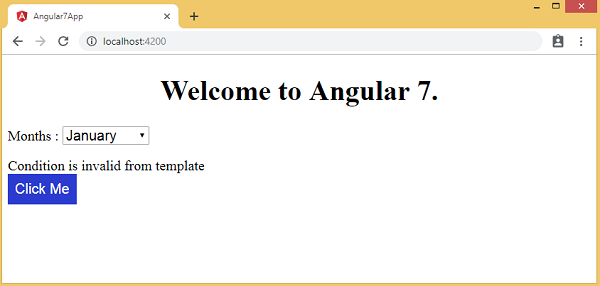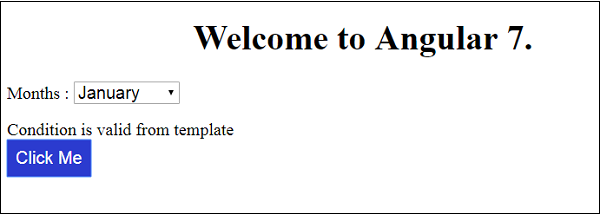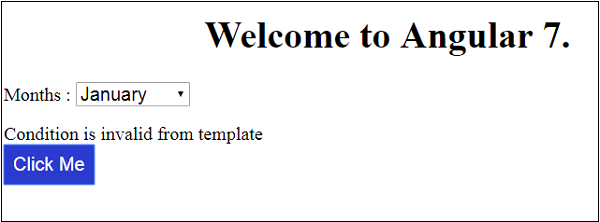Angular 7 использует <ng-template> в качестве тега вместо <template>, который используется в Angular2. <ng-template> используется с момента выпуска Angular 4, а более ранняя версия, то есть Angular 2, использует <template> для той же цели. Причина, по которой он начал использовать <ng-template> вместо <template> начиная с Angular 4, заключается в том, что существует конфликт имен между тегом <template> и стандартным тегом html <template>. Это будет полностью устаревать. Это было одно из основных изменений, внесенных в версию Angular 4.
Давайте теперь использовать шаблон вместе с условием if else и посмотрим на результат.
app.component.html
<!--The content below is only a placeholder and can be replaced.--> <div style = "text-align:center"> <h1>Welcome to {{title}}.</h1> </div> <div> Months : <select (change) = "changemonths($event)" name = "month"> <option *ngFor = "let i of months">{{i}}</option> </select> </div> <br/> <div> <span *ngIf = "isavailable;then condition1 else condition2"> Condition is valid. </span> <ng-template #condition1>Condition is valid from template</ng-template> <ng-template #condition2>Condition is invalid from template</ng-template> </div> <button (click) = "myClickFunction($event)">Click Me</button>
Для тега Span мы добавили оператор if с условием else и будем вызывать шаблон условие1, иначе условие2.
Шаблоны должны называться следующим образом —
<ng-template #condition1>Condition is valid from template</ng-template> <ng-template #condition2>Condition is invalid from template</ng-template>
Если условие истинно, то вызывается шаблон condition1 , в противном случае condition2 .
app.component.ts
import { Component } from '@angular/core'; @Component({ selector: 'app-root', templateUrl: './app.component.html', styleUrls: ['./app.component.css'] }) export class AppComponent { title = 'Angular 7'; // declared array of months. months = ["January", "February", "March", "April", "May", "June", "July", "August", "September", "October", "November", "December"]; isavailable = false; // variable is set to true myClickFunction(event) { //just added console.log which will display the event details in browser on click of the button. alert("Button is clicked"); console.log(event); } changemonths(event) { alert("Changed month from the Dropdown"); } }
Вывод в браузере выглядит следующим образом —
Переменная isavailable имеет значение false, поэтому печатается шаблон condition2. Если вы нажмете кнопку, будет вызван соответствующий шаблон.
app.component.ts
import { Component } from '@angular/core'; @Component({ selector: 'app-root', templateUrl: './app.component.html', styleUrls: ['./app.component.css'] }) export class AppComponent { title = 'Angular 7'; // declared array of months. months = ["January", "Feburary", "March", "April", "May", "June", "July", "August", "September", "October", "November", "December"]; isavailable = false; //variable is set to true myClickFunction(event) { this.isavailable = !this.isavailable; // variable is toggled onclick of the button } changemonths(event) { alert("Changed month from the Dropdown"); } }
Переменная isavailable переключается при нажатии кнопки, как показано ниже —
myClickFunction(event) { this.isavailable = !this.isavailable; }
Когда вы нажимаете на кнопку, основываясь на значении переменной isavailable, соответствующий шаблон будет отображаться —
Если вы проверите браузер, вы увидите, что вы никогда не получите тег span в DOM. Следующий пример поможет вам понять то же самое.
Хотя в app.component.html мы добавили тег span и <ng-template> для условия, как показано ниже —
<span *ngIf = "isavailable;then condition1 else condition2"> Condition is valid. </span> <ng-template #condition1>Condition is valid from template</ng-template> <ng-template #condition2>Condition is invalid from template</ng-template>
Мы не видим тег span, а также <ng-template> в структуре dom, когда проверяем их в браузере.
Следующая строка кода в html поможет нам получить тег span в dom —
<!--The content below is only a placeholder and can be replaced.--> <div style = "text-align:center"> <h1> Welcome to {{title}}. </h1> </div> <div> Months : <select (change) = "changemonths($event)" name = "month"> <option *ngFor = "let i of months">{{i}}</option> </select> </div> <br/> <div> <span *ngIf = "isavailable; else condition2"> Condition is valid. </span> <ng-template #condition1>Condition is valid from template </ng-template> <ng-template #condition2>Condition is invalid from template</ng-template> </div> <button (click) = "myClickFunction($event)">Click Me</button>
Если мы удалим условие then , мы получим сообщение «Условие действительно» в браузере, а тег span также доступен в DOM. Например, в app.component.ts мы сделали переменную isavailable равной true.



